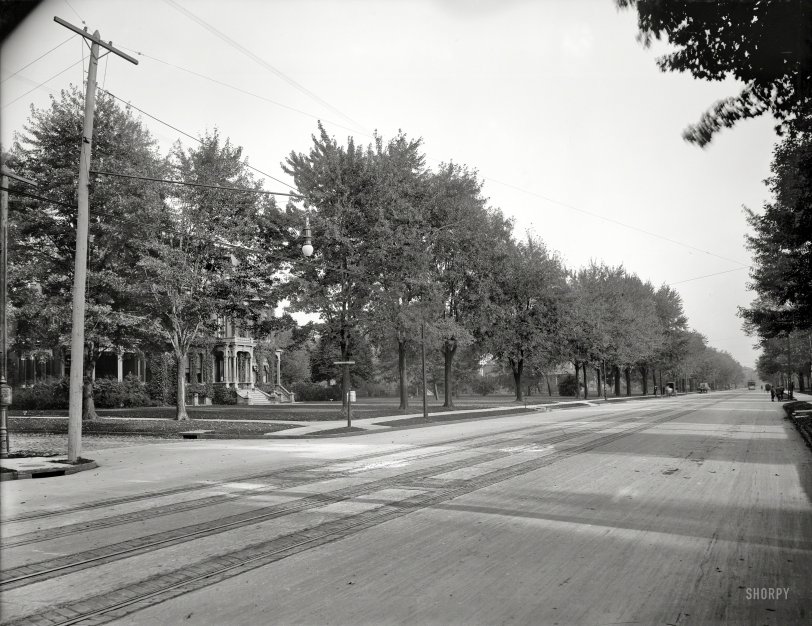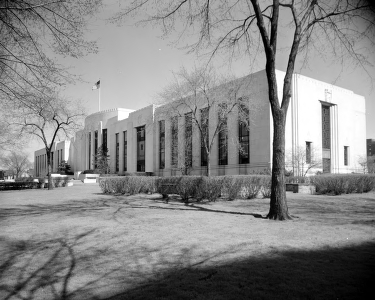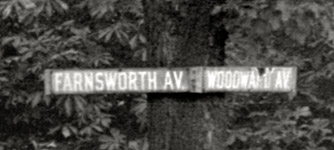


Framed or unframed, desk size to sofa size, printed by us in Arizona and Alabama since 2007. Explore now.
Shorpy is funded by you. Patreon contributors get an ad-free experience.
Learn more.

- Baldwin 62303
- Baldwin VO-1000
- Cold
- No expense spared
- Tough Guys
- Lost in Toyland
- And without gloves
- If I were a blindfolded time traveler
- Smoke Consumer Also Cooks
- Oh that stove!
- Possibly still there?
- What?!?
- $100 Reward
- Freeze Frame
- Texas Flyer wanted
- Just a Year Too Soon
- WWII -- Replacing men with women at the railroad crossing.
- Yes, Icing
- You kids drive me nuts!
- NOT An Easy Job
- I wonder
- Just add window boxes
- Icing Platform?
- Indiana Harbor Belt abides
- Freezing haze
- Corrections (for those who care)
- C&NW at Nelson
- Fallen Flags
- A dangerous job made worse
- Water Stop
Print Emporium
Traffic Ahead: 1901

Detroit circa 1901. "Woodward Avenue and Farnsworth Street." The future Motor City on the cusp of the Motor Century. 8x10 inch glass negative. View full size.
Previously on Shorpy
Looking up Farnsworth in this Kodachrome from 1942. One of the photos that helped get me addicted to Shorpy way back when.
Actually, Cater-Corner From the Library
This view is looking southeast at the corner of Woodward and Farnsworth. Farnsworth does not extend west of Woodward (the street to the west of Woodward is named Putnam). The future (and current) site of Main Library is thus out of view to the far right of the picture. Similarly, the site of the Detroit Institute of Arts, to the northeast of this corner, is out of view to the far left.
The location shown is now the site of the Horace Rackham Education Memorial Building (opened in 1941), which was originally built for the Engineering Society of Detroit, but is now owned by the University of Michigan and largely leased to Wayne State University.

Detroit Institute of Arts
and the main library, across the street. The only two things on Woodward Avenue that don't make me think I was born 75 years too late.
bjzielinski's Street View is in front of the Maccabees Building, original (radio) home of The Lone Ranger.
Re: Pole Climbing
The town here in Texas where I grew up still had the metal climbing steps on poles in the late 70s, but by then the bottom steps had been raised about 7 or 8 feet off the sidewalk, probably to keep adventurous kids from climbing the poles.
I always wondered what the world looked like from the top of a pole.
That location
That location would be Woodward Avenue and Farnsworth Street.
[Incorrect. - Dave]

Those poles and the pulley
The metal poles are for the trolley car company's wires. More prosperous lines used metal because it lasted almost forever. Philadelphia still uses some that were erected at the start of electric service in the mid 1890s, although they have received new paint, and some have rusted to death from the inside.
The light on a rope might be an arc light, whose carbons need periodic adjustment. The trolley workers can climb on top of one of their cars to get to their wires in the middle of the street, while the electric company's men climb poles, in this case to disconnect wires so the light can be brought within reach of an adjuster on the ground.
Poles
Mark, those are arc lights, which were high maintenance compared to later incandescent and todays bulbs. Note the transformer on the pole just below the attachment of the bracket arm, the wires dropping down to it from the crossarm, and the low voltage wires hanging in a catenary shaped arc to the lamp fixture. Arc lights were much brighter and lower maintenance than oil lights. The carbon rods had to be replaced regularly, but nowhere near the daily schedule required of oil or gas lamps.
Two methods were common for the way to lower the lamps. Often, the metal arm which reached out over the center of the street or intersection would be pivoted to the pole, and the winch would lower the whole arm through an arc to a level where the worker could perform his duties. In this picture, lowering the metal cantilever could interfere with the trolley wires, so the arm was mounted rigidly and the lamp was lowered straight down to service it.
The metal poles in the background were for the trolley line. Wooden poles were used in the early days, round metal pipe poles with a bell shaped cap were very common, and metal lattice as seen in this picture were used to a lesser extent.
Current view
About those poles
Power poles could be and WERE made from a number of different materials, although wood was the preferred medium. In western New York, many power poles and street lamp poles from this time period were made from reinforced concrete, which wasn't surprising because the County Engineer "happened" to own a batching plant. But like them or not, they were still usable until the late 1950s and early 60s. The metal poles that replaced them only lasted and twenty to twenty-five years.
Library
It looks like this photo is looking north along Woodward. If so, then the main branch of the Detroit Public Library was built in the open area to the right of the second house.
Designed by Cass Gilbert, the library was started with a $750,000 gift by Andrew Carnegie. He offered the money in 1901, but the city didn't get around to accepting until 1910. Some things don't change.
Eventually, the houses were replaced by the front lawn of the library, probably when it expanded in the '60s.
Pole Climbing
Some telephone poles still had the climbing steps in them when I grew up on the 50s.
Since then they've discovered climbing spurs.
Interesting poles for sure
Three quick Shorpy questions:
1. The street lamp almost in the middle of the photo appears to have a pulley and rope, extending down the pole to the street. Is this light now electrified, where its predecessor perhaps was oil-fired, requiring raising and lowering the lamp twice daily for lighting and extinguishing, plus re-filling the oil?
2. The other poles which seem to be handling electricity, also basically in the center of the photo, appear to be metal. since they're honey-combed in the middle. I would have thought wood was the preferred pole material. Were these man-made (and fairly stylish) back in 1901?
3. Finally, I hope someone shows us that intersection today. Bet it looks incredibly different now.
























On Shorpy:
Today’s Top 5